GEEKOM AS 6 (ASUS PN53) Review: Ryzen 9 6900HX Packs Punches in a Petite Package
by Ganesh T S on July 31, 2023 8:00 AM ESTHTPC Credentials
The 2022 Q4 update to our system reviews brings an updated HTPC evaluation suite for systems. After doing away with the evaluation of display refresh rate stability and Netflix streaming evaluation, the local media playback configurations have also seen a revamp. This section details each of the workloads processed on the GEEKOM AS 6 (ASUS PN53) as part of the HTPC suite.
YouTube Streaming Efficiency
YouTube continues to remain one of the top OTT platforms, primarily due to its free ad-supported tier. Our HTPC test suite update retains YouTube streaming efficiency evaluation as a metric of OTT support in different systems. Mystery Box's Peru 8K HDR 60FPS video is the chosen test sample. On PCs running Windows, it is recommended that HDR streaming videos be viewed using the Microsoft Edge browser after putting the desktop in HDR mode.
The GPU in GEEKOM AS 6 (ASUS PN53) supports hardware decoding of VP9 Profile 2, and we see the stream encoded with that codec being played back. The streaming is perfect, thanks to the powerful GPU and hardware decoding support - the few dropped frames observed in the statistics below are due to mouse clicks involved in bringing up the overlay and the transition to different encode resolutions in the initial stages.
The streaming efficiency-related aspects such as GPU usage and at-wall power consumption are also graphed below.
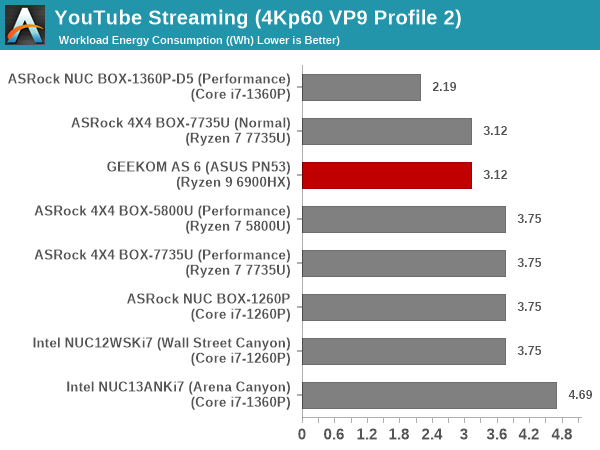
The NUC BOX-1360P/D5 RPL-P system is the most energy efficient of the tested lot by a huge margin, but the Rembrandt systems (including the GEEKOM AS 6) slot in right behind.
Hardware-Accelerated Encoding and Decoding
The transcoding benchmarks in the systems performance section presented results from evaluating the VCE encoder within Handbrake's framework. The capabilities of the decoder engine are brought out by DXVAChecker.
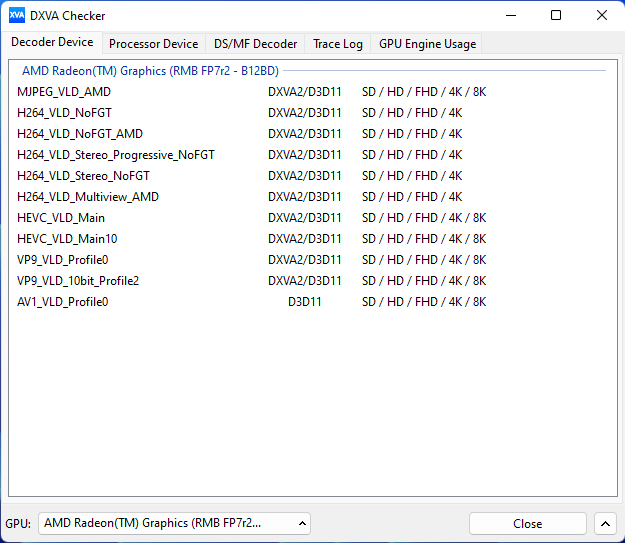
Video Decoding Hardware Acceleration in GEEKOM AS 6 (ASUS PN53)
On paper, this codec list is quite comprehensive and should cover most home consumer and digital signage requirements
Local Media Playback
Evaluation of local media playback and video processing is done by playing back files encompassing a range of relevant codecs, containers, resolutions, and frame rates. A note of the efficiency is also made by tracking GPU usage and power consumption of the system at the wall. Users have their own preference for the playback software / decoder / renderer, and our aim is to have numbers representative of commonly encountered scenarios. Our Q4 2022 test suite update replaces MPC-HC (in LAV filters / madVR modes) with mpv. In addition to being cross-platform and open-source, the player allows easy control via the command-line to enable different shader-based post-processing algorithms. From a benchmarking perspective, the more attractive aspect is the real-time reporting of dropped frames in an easily parseable manner. The players / configurations considered in this subsection include:
- VLC 3.0.18
- Kodi 20.2
- mpv 0.35.1 (hwdec auto, vo=gpu-next)
- mpv 0.35.1 (hwdec auto, vo=gpu-next, profile=gpu-hq)
Fourteen test streams (each of 90s duration) were played back from the local disk with an interval of 30 seconds in-between. Various metrics including GPU usage, at-wall power consumption, and total energy consumption were recorded during the course of this playback.
All our playback tests were done with the desktop HDR setting turned on. It is possible for certain system configurations to automatically turn on/off the HDR capabilities prior to the playback of a HDR video, but, we didn't take advantage of that in our testing.
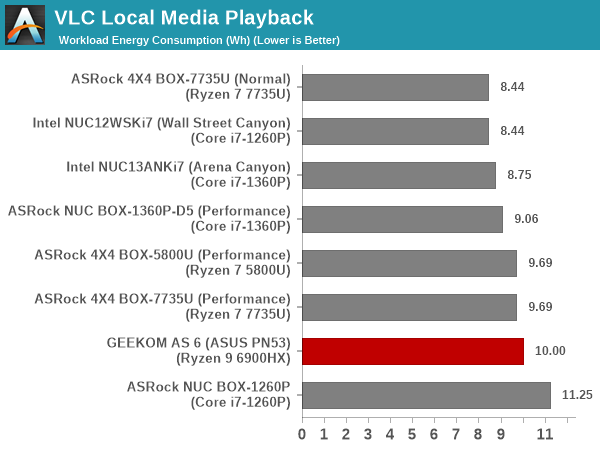
Lower TDP Rembrandt systems fare better in the energy consumption metric. All codecs play back well, except for the AV1 clip. VLC doesn't take advantage of the GPU hardware decoding capabilities for that codec. As a result, the playback for that clip, as well as the energy numbers are not ideal in the GEEKOM AS 6.
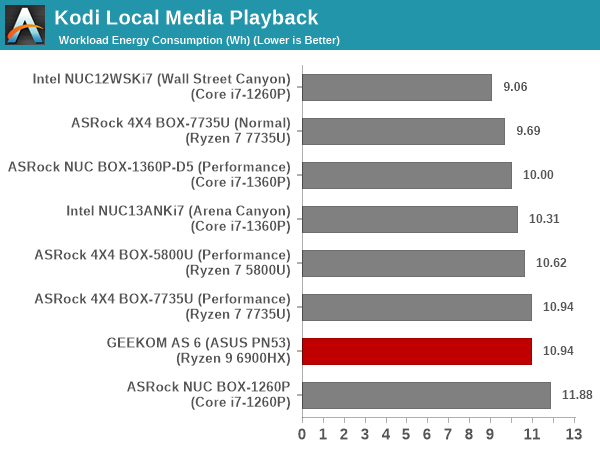
The user experience with Kodi is not much different, as AV1 hardware acceleration is again unused. Since the Kodi GUI is kept active at the main screen between the playback of different streams, the GPU remains active and continues to render the UI. This results in the energy numbers creeping up when the full playback period is considered.

AV1 decode acceleration is utilized by mpv. Unfortunately, despite the decoder engine running at full tilt, there is some problem with the video output path resulting in approximately half the frames getting dropped. In terms of energy efficiency, the GEEKOM AS 6 is slotted in the middle of the pack.
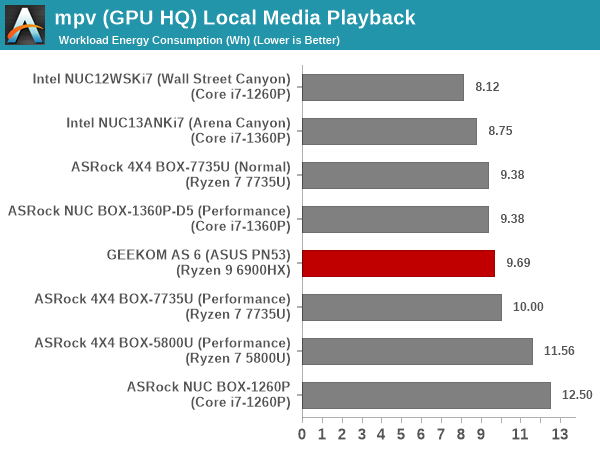
The case of the AV1 playback being spotty despite the hardware acceleration is seen here again. The activation of the GPU shaders for rendering in the GPU-HQ case results in relatively higher energy numbers for all the systems.


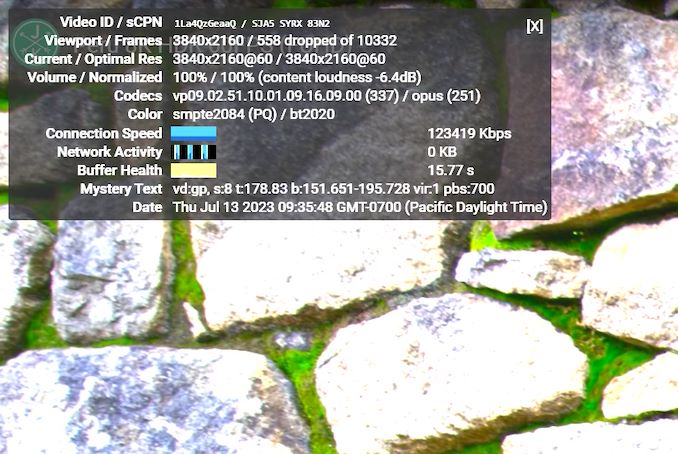
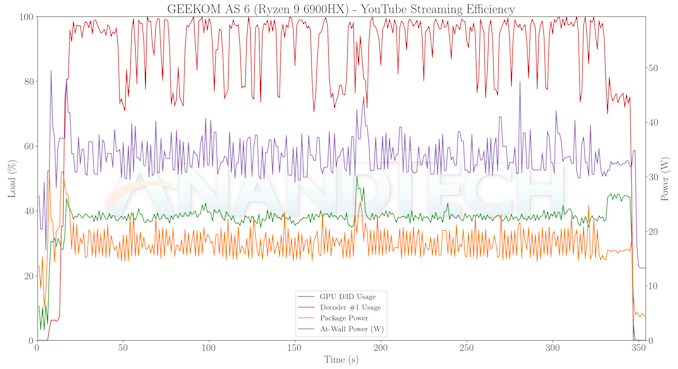
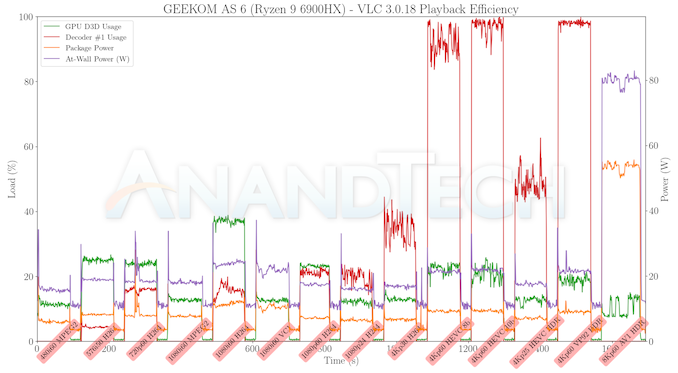
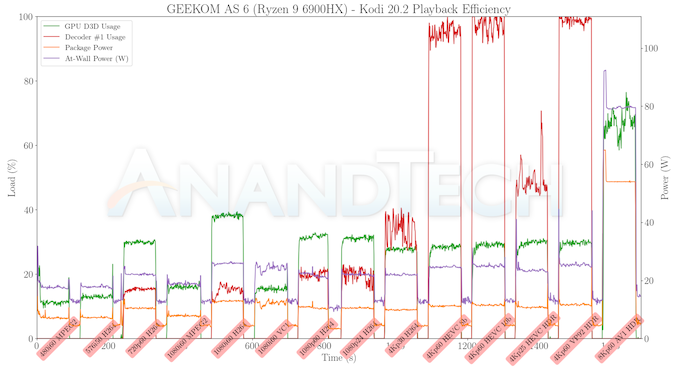
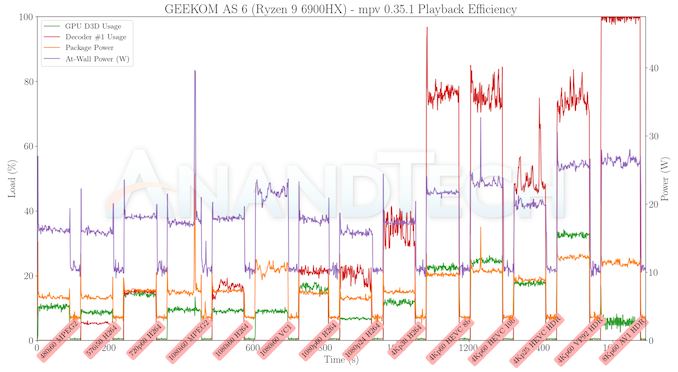
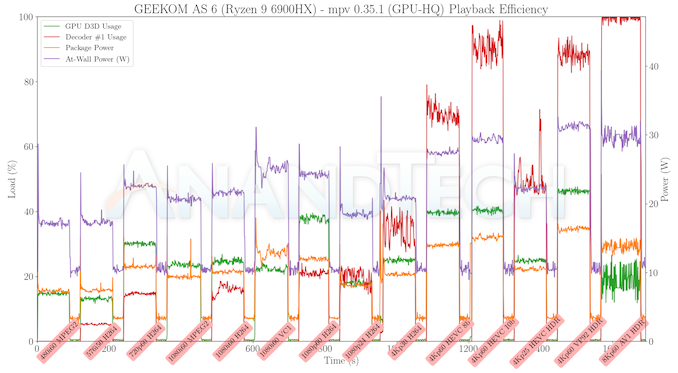








14 Comments
View All Comments
MTEK - Monday, July 31, 2023 - link
HDMI 2.0 and not 2.1. It's 2023. Why is this still happening?nandnandnand - Monday, July 31, 2023 - link
It's a previous-gen part, for one.Does it even need the features or bandwidth of HDMI 2.1?
shabby - Monday, July 31, 2023 - link
First, the beelink gtr6 with the exact sand cpu supports hdmi 2.1Second it was released just last year.
Third, yes I do need all that bandwidth.
Fourth... Just because.
heffeque - Monday, July 31, 2023 - link
They reviewed a fairly "old" mini-PC.All 7040HS mini-PCs have HDMI 2.1
Drkrieger01 - Monday, July 31, 2023 - link
The more 'features' a product has, the more it is likely to cost. Just because a chipset supports a features, doesn't mean it will have it in the product. It may require more electronic components to make the 'feature' functional, which translates to higher product cost overall (or the company may blame that).Also, with an integrated chipset, what is it that you plan to run at the bandwidth of HDMI 2.1? This unit will likely only play video, not games at that resolution/refresh rate.
Drkrieger01 - Monday, July 31, 2023 - link
Also, DisplayPort 1.4a is capable of 4K@96Hz, 8K@30Hz. HDMI 2.0 can only do 4K@60Hz. DisplayPort 1.4a is far superior to HDMI 2.0.meacupla - Monday, July 31, 2023 - link
That is an oddly complex daughterboard.That is the fattest and longest ribbon cable I have ever seen in a miniPC or laptop.
And it seemingly doesn't have to be that long, if the daughterboard wasn't attached to the base that opens up like a clam shell.
rUmX - Monday, July 31, 2023 - link
No AV1 video encoding benchmarks? I think SVT-AV1 should be included. H264/H265 are now ancient codecs.AdrianBc - Tuesday, August 1, 2023 - link
None of these older integrated GPUs support AV1 encoding in hardware.AV1 encoding is supported now in the AMD Phoenix Ryzen 7040 series and it will be supported in the Intel Meteor Lake Core Ultra series, which will be launched by the end of the year.
There already are many models of small computers with Ryzen 7 7840U, Ryzen 7 7840HS or Ryzen 9 7940HS, which support AV1 encoding in real time of several video streams in parallel.
meacupla - Tuesday, August 1, 2023 - link
Mobile Ryzen 6000 only has AV1 decode.